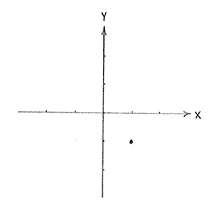Solution 4.1:7d
From Förberedande kurs i matematik 1
(Difference between revisions)
m |
|||
| (3 intermediate revisions not shown.) | |||
| Line 1: | Line 1: | ||
| - | + | We rewrite the equation in standard form by completing the square for the ''x''- and ''y''-terms, | |
| - | + | ||
| - | <center> [[ | + | {{Displayed math||<math>\begin{align} |
| - | + | x^{2} - 2x &= (x-1)^2 - 1^2\,,\\[5pt] | |
| + | y^{2} + 2y &= (y+1)^2 - 1^2\,\textrm{.} | ||
| + | \end{align}</math>}} | ||
| + | |||
| + | Now, the equation is | ||
| + | |||
| + | {{Displayed math||<math>\begin{align} | ||
| + | (x-1)^2 - 1 + (y+1)^2 - 1 &= -2\\ | ||
| + | \Leftrightarrow\quad (x-1)^2 + (y+1)^2 &= 0\,\textrm{.} | ||
| + | \end{align}</math>}} | ||
| + | |||
| + | The only point which satisfies this equation is <math>(x,y) = (1,-1)</math> because, for all other values of ''x'' and ''y'', the left-hand side is strictly positive and therefore not zero. | ||
| + | |||
| + | |||
| + | <center> [[Image:4_1_7_d.gif]] </center> | ||
Current revision
We rewrite the equation in standard form by completing the square for the x- and y-terms,
| \displaystyle \begin{align}
x^{2} - 2x &= (x-1)^2 - 1^2\,,\\[5pt] y^{2} + 2y &= (y+1)^2 - 1^2\,\textrm{.} \end{align} |
Now, the equation is
| \displaystyle \begin{align}
(x-1)^2 - 1 + (y+1)^2 - 1 &= -2\\ \Leftrightarrow\quad (x-1)^2 + (y+1)^2 &= 0\,\textrm{.} \end{align} |
The only point which satisfies this equation is \displaystyle (x,y) = (1,-1) because, for all other values of x and y, the left-hand side is strictly positive and therefore not zero.

